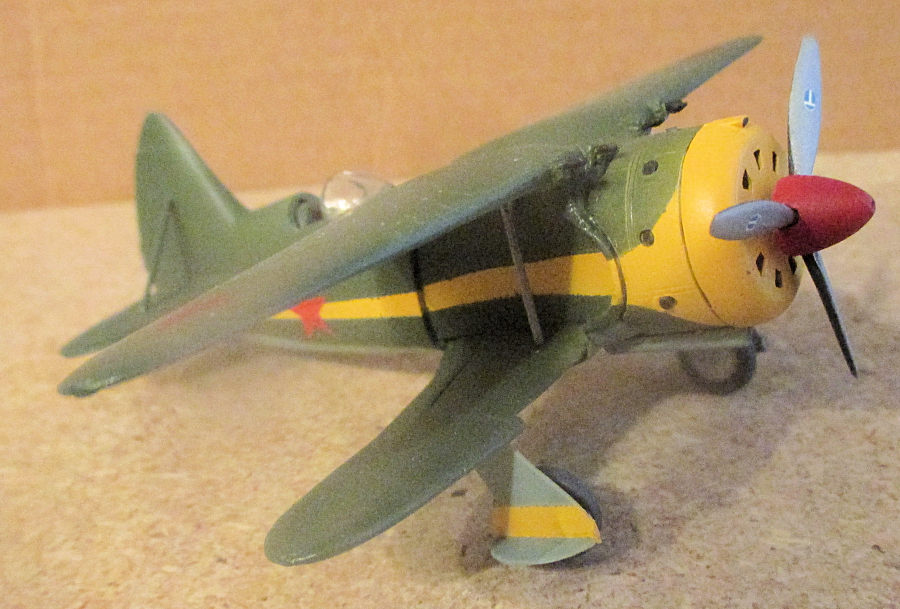
A-Model 1/72 Nikitin-Sevchenko IS-1
| KIT #: | 7246 |
| PRICE: | $ |
| DECALS: | One option |
| REVIEWER: | Brian Baker |
| NOTES: | Short run |

| HISTORY |
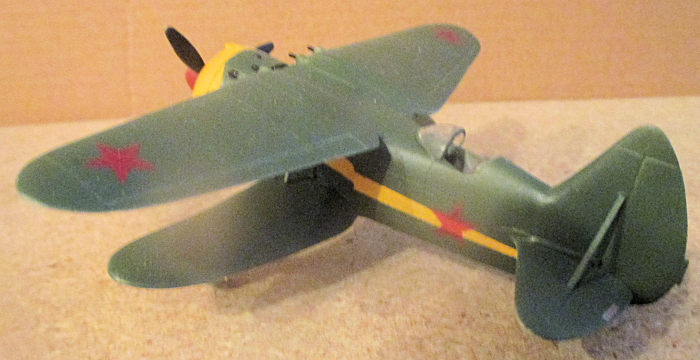 Fighter
development in the Soviet Union during the thirties followed parallel courses,
as monoplanes began to replace biplanes. Beginning with the advanced Polikarpov
I-16 series, the Russians had developed a fighter which was as good as any in
the world. The Soviet high command, while espousing the low wing monoplane,
didn’t totally abandon the concept of the biplane fighter as it still seemed to
have some advantages, and production continued with the I-15 and I-153 biplanes.
At the beginning of World War II, which the Russians dubbed the “Great Patriotic
War”, many biplane fighters were still in service, and the biplane still
appeared to have a future.
Fighter
development in the Soviet Union during the thirties followed parallel courses,
as monoplanes began to replace biplanes. Beginning with the advanced Polikarpov
I-16 series, the Russians had developed a fighter which was as good as any in
the world. The Soviet high command, while espousing the low wing monoplane,
didn’t totally abandon the concept of the biplane fighter as it still seemed to
have some advantages, and production continued with the I-15 and I-153 biplanes.
At the beginning of World War II, which the Russians dubbed the “Great Patriotic
War”, many biplane fighters were still in service, and the biplane still
appeared to have a future.
One rather bizarre approach to the problem, the Nikitin-Sevchenko IS-1 prototype, actually was able to change from a biplane to a monoplane in flight, appearing to have the advantages of the biplane at first, and shifting to the fasted high wing monoplane when the lower wing was folded up into a receptacle in the lower portion of the upper wing. One prototype was completed in 1940, and flight tests showed that although the idea did work, it probably wouldn’t be very practical, and the simpler structure of the monoplane would b e infinitely superior. The IS-1 was powered by an M-63 radial engine, and had a retractable landing gear which folded up into the lower wings. A later version, the IS-2, had a more powerful engine, but in the end, both were abandoned as being too impractical.
| THE KIT |
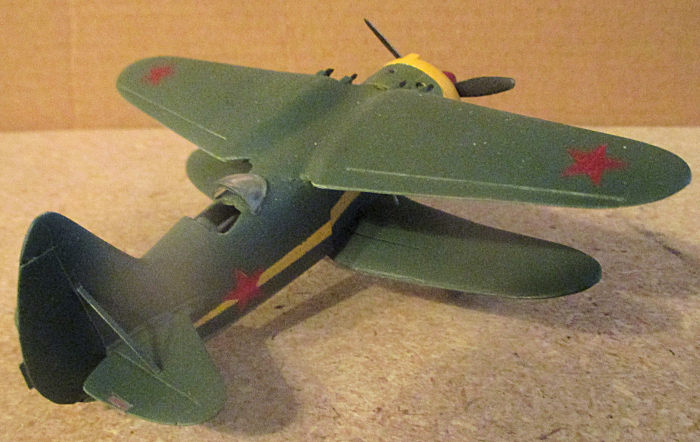 The kit is
molded in grey styrene, and consists of three sprues, along with one very small
clear plastic sprue, which provides the windshield. The cockpit interior is very
nicely done, with sidewall structure, a floor, seat, rear bulkhead, control
stick, and instrument panel. The assembled structure fits nicely inside of the
fuselage halves.
The kit is
molded in grey styrene, and consists of three sprues, along with one very small
clear plastic sprue, which provides the windshield. The cockpit interior is very
nicely done, with sidewall structure, a floor, seat, rear bulkhead, control
stick, and instrument panel. The assembled structure fits nicely inside of the
fuselage halves.
The instructions are printed on one 8 ˝ x 11” sheet of paper divided into four sections. Page 1 has a drawing of the aircraft (cover drawing) and some technical details in English and Russian. Page 2 has a color guide and a sprue diagram, Page 3 has 4 exploded assembly diagrams, and page 4 has the final assembly drawing and a color guide. All drawings and information are clearly printed.
There is some information on this aircraft in William Green’s War Planes of the Second World War, Vol. 3, Fighters, on pages 150-152, and more information can be found on line. Remember that only one of these aircraft was built, and few people have ever heard of it. That’s what makes it so interesting.
| CONSTRUCTION |
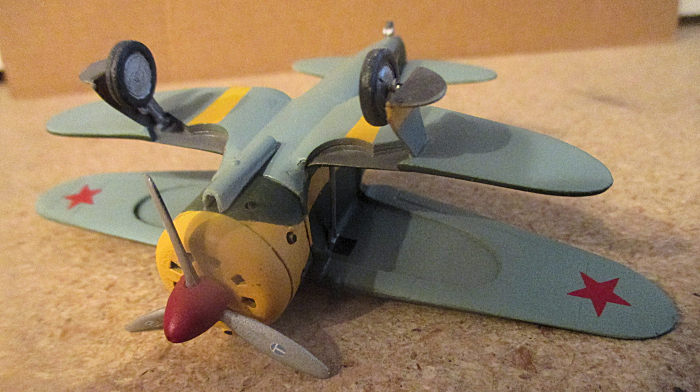 The kit
is designed to be built in either the biplane or monoplane configuration, and
the instructions tell how to deal with the differences. The engine is quite
detailed, with the main crankcase, the forward portion with the pushrod
housings, and the rear section, which has the exhaust stacks. The upper wing is
cast in one piece, while the lower wing can have the landing gear folded up in
monoplane configuration, or lowered, as a biplane. Your choice here. If you want
the gear down, it has to be a biplane unless you want to model it bellied in.
Ugh!
The kit
is designed to be built in either the biplane or monoplane configuration, and
the instructions tell how to deal with the differences. The engine is quite
detailed, with the main crankcase, the forward portion with the pushrod
housings, and the rear section, which has the exhaust stacks. The upper wing is
cast in one piece, while the lower wing can have the landing gear folded up in
monoplane configuration, or lowered, as a biplane. Your choice here. If you want
the gear down, it has to be a biplane unless you want to model it bellied in.
Ugh!
For its size, this kit has a lot of detail, and it goes together very easily. You just have to follow the instructions religiously.
| COLORS & MARKINGS |
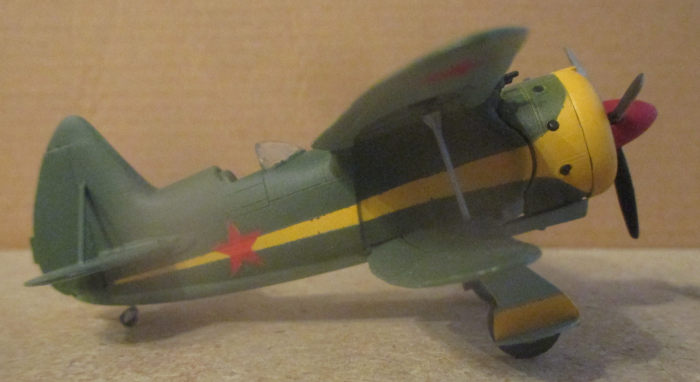 Since
there was only one prototype of this particular aircraft, there is only one
color scheme. The upper surfaces are Russian green, while the undersides are
light blue. The nose and side trim are yellow, and although decals are provided
for most of the yellow trim, I opted for yellow paint and masking, which I think
looks better than trying to set up decals over the round cowling.
Since
there was only one prototype of this particular aircraft, there is only one
color scheme. The upper surfaces are Russian green, while the undersides are
light blue. The nose and side trim are yellow, and although decals are provided
for most of the yellow trim, I opted for yellow paint and masking, which I think
looks better than trying to set up decals over the round cowling.
| CONCLUSIONS |
This kit makes up into a very nice little model, and I didn’t have any problems with any phase of the assembly. If you put one of these on your display shelf, be sure to add a caption explaining what it is, as most people will not be familiar with the type. It is worth getting one of these, and I understand there is a kit available of the IS-2, although I haven’t seen one. Highly recommended.
23 April 2020
Copyright ModelingMadness.com
If you would like your product reviewed fairly and fairly quickly, please contact the editor or see other details in the Note to Contributors.
Back to the Main Page Back to the Review Index Page Back to the Previews Index Page